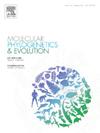小麦草的基因组研究:揭示小麦草属植物的遗传多样性、种群结构和进化动力学。
IF 3.6
1区 生物学
Q2 BIOCHEMISTRY & MOLECULAR BIOLOGY
引用次数: 0
摘要
假根属植物是温带多年生禾本科植物的异交种,具有重要的生态和农业价值。了解其遗传多样性和种群结构的范围和模式,对这些物种的育种改良和保护具有重要意义。在本研究中,我们利用基因分型测序技术分析了来自全球主要谱系的7种(spicata P., tauri P., geniculata P., libanotica P., strigosa P., stipifolia P.,和P. cognata) 145个基因型的基因组变异。利用核苷酸多样性、观察杂合度和Tajima’s D等指标评价不同种群间的遗传多样性,发现种间存在显著差异,其中刺桐的遗传多样性最高,而spicata的遗传多样性最低。种群结构分析,包括主成分分析、混合推断和系统发育重建,鉴定出6个不同的遗传集群,其中spicata(一个北美物种)与其他6个物种明显分离,强调其独特的遗传身份。相比之下,欧亚物种表现出混合的祖先,表明复杂的遗传关系和广泛的遗传物质交换。此外,没有一个单一的物种树能完全捕捉到它们之间的关系,这意味着在密切相关的物种之间存在着杂交或基因流动等相互作用。为了研究欧亚地区假根属物种的进化历史,我们基于SNV (single nucleotide variants)矩阵重构了种树拓扑结构,f分支统计证实了spicata、P. libanotica和P. tauri之间的密切关系,并证明了P. stipifolia、P. geniculata和P. striigosa之间存在单向基因流动。这些发现突出了刺桐种群中高遗传变异的重要性,表明它有可能成为具有弹性基因型的有价值等位基因的储存库。本文章由计算机程序翻译,如有差异,请以英文原文为准。

Genomic insights into wheatgrass: unravelling genetic diversity, population structure, and evolutionary dynamics in Pseudoroegneria species
Pseudoroegneria species are outcrossing perennial grasses with significant ecological and agricultural value due to its resilience in challenging environmental conditions in the temperate regions. Understanding the extent and pattern of genetic diversity and population structure is essential for the breeding improvement and conservation of these species. In the current research, we analyzed genomic variations of 145 genotypes representing seven species (P. spicata, P. tauri, P. geniculata, P. libanotica, P. strigosa, P. stipifolia, and P. cognata) from major global lineages, using genotyping-by-sequencing. Different metrics including nucleotide diversity, observed heterozygosity, and Tajima’s D were used to evaluate genetic diversity among populations revealing significant variation among species, with P. stipifolia exhibiting the highest diversity and P. spicata the lowest. Population structure analyses, including principal component analysis, admixture inference, and phylogenetic reconstruction, identified six distinct genetic clusters, with P. spicata (a North American species) clearly separated from the other six species underscoring its unique genetic identity. In contrast, the Eurasian species exhibit mixed ancestry, indicating intricate genetic relationships and widespread exchange of genetic material. Furthermore, no single species tree fully captures the relationships among them, implying interactions such as hybridization or gene flows between closely related species. To investigate the evolutionary history of Eurasian Pseudoroegneria species, we reconstructed the species tree topology based on the SNV (single nucleotide variants) matrix, and f-branch statistics confirmed close relationships among P. spicata, P. libanotica, and P. tauri, with evidence of unidirectional gene flow between P. stipifolia, P. geniculata, and P. strigosa. These findings highlight the importance of high genetic variation in the P. stipifolia population, suggesting its potential to be a reservoir of valuable alleles for resilient genotypes.
求助全文
通过发布文献求助,成功后即可免费获取论文全文。
去求助
来源期刊
CiteScore
7.50
自引率
7.30%
发文量
249
审稿时长
7.5 months
期刊介绍:
Molecular Phylogenetics and Evolution is dedicated to bringing Darwin''s dream within grasp - to "have fairly true genealogical trees of each great kingdom of Nature." The journal provides a forum for molecular studies that advance our understanding of phylogeny and evolution, further the development of phylogenetically more accurate taxonomic classifications, and ultimately bring a unified classification for all the ramifying lines of life. Phylogeographic studies will be considered for publication if they offer EXCEPTIONAL theoretical or empirical advances.

 求助内容:
求助内容: 应助结果提醒方式:
应助结果提醒方式:


